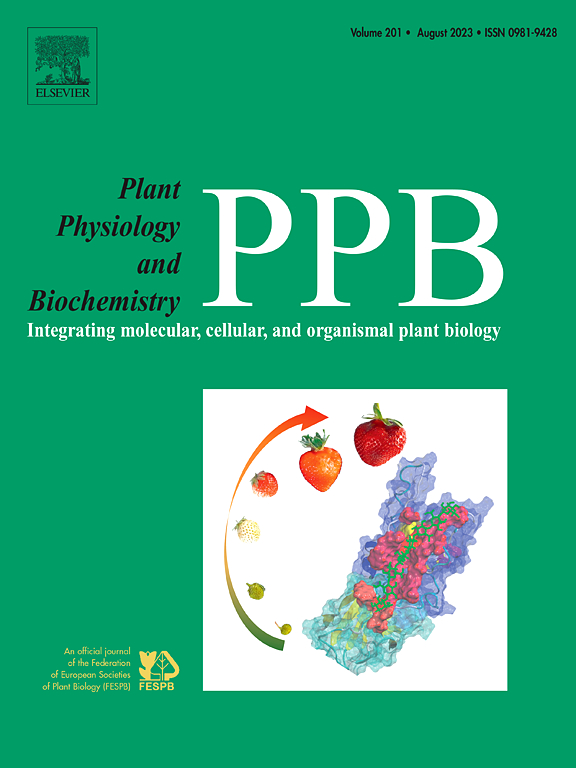The Rhododendron agastum flavonoid 3-O-glycosyltransferase Ra3GT2 contributes to salt and drought stress tolerance through modulating anthocyanin synthesis
IF 5.7
2区 生物学
Q1 PLANT SCIENCES
引用次数: 0
Abstract
Flavonoid 3-O-glycosyltransferases (3GTs), in charge of transferring UDP-sugars to 3-OH position of small substrates, control a variety of metabolic processes in plants. Extensive research about 3GTs has been centered in model plants, but little in Rhododendron. Here, three 3GT genes (Ra3GT1-3) were isolated from R. agastum flowers. Based on analyses of sequence alignment and phylogenetic tree, only Ra3GT2 had the full-length ORF and was grouped into the set of flavonoid 3-O-glycosyltransferase, so it was selected for further characterization. Ra3GT2 expression during R. agastum flower development did not align with anthocyanin accumulation, suggesting it may glycosylate both anthocyanidins and other flavonoids. The function of Ra3GT2 in vivo was identified in ugt78d2 mutant as well as K326 tobacco, and the data revealed that Ra3GT2 transgenes could restore the purple color of the ugt78d2 seedlings and deepen the flower color of tobacco via regulating the expressions of endogenous genes participated in anthocyanin synthesis. Furthermore, Ra3GT2 was confirmed to modify flavonoids through adding UDP-glucose and UDP-galactose to the 3-OH of anthocyanidins and flavonols. Ra3GT2 overexpression enhanced salt and drought tolerance in both Arabidopsis and E. coli, whereas the ugt78d2 mutant and control strains were more stress-sensitive. Taken together, we demonstrate that Ra3GT2 plays important roles in modulating anthocyanin biosynthesis as well as enviromental stress tolerance.
杜鹃类黄酮3- o -糖基转移酶Ra3GT2通过调控花青素合成参与盐胁迫和干旱胁迫
黄酮类3- o -糖基转移酶(Flavonoid 3-O-glycosyltransferases, 3gt)负责将小底物的udp -糖转移到3-OH位置,控制着植物的多种代谢过程。关于3gt的大量研究主要集中在模式植物中,但对杜鹃花的研究很少。本研究从牛蒡花中分离到3个3GT基因(Ra3GT1-3)。通过序列比对和系统进化树分析,只有Ra3GT2具有全长ORF,并被归为类黄酮3- o -糖基转移酶集合,因此选择Ra3GT2进行进一步表征。在花发育过程中,Ra3GT2的表达与花青素的积累不一致,提示其可能对花青素和其他类黄酮进行糖基化。在ugt78d2突变体和K326烟草中鉴定了Ra3GT2在体内的功能,数据显示,Ra3GT2转基因可以通过调节参与花青素合成的内源基因的表达,恢复ugt78d2幼苗的紫色,加深烟草的花色。此外,Ra3GT2通过在花青素和黄酮醇的3-OH上添加udp -葡萄糖和udp -半乳糖来修饰黄酮类化合物。Ra3GT2过表达增强了拟南芥和大肠杆菌对盐和干旱的耐受性,而ugt78d2突变株和对照株对胁迫更敏感。综上所述,我们证明了Ra3GT2在调节花青素生物合成和环境胁迫耐受性中起重要作用。
本文章由计算机程序翻译,如有差异,请以英文原文为准。
求助全文
约1分钟内获得全文
求助全文
来源期刊
CiteScore
11.10
自引率
3.10%
发文量
410
审稿时长
33 days
期刊介绍:
Plant Physiology and Biochemistry publishes original theoretical, experimental and technical contributions in the various fields of plant physiology (biochemistry, physiology, structure, genetics, plant-microbe interactions, etc.) at diverse levels of integration (molecular, subcellular, cellular, organ, whole plant, environmental). Opinions expressed in the journal are the sole responsibility of the authors and publication does not imply the editors'' agreement.
Manuscripts describing molecular-genetic and/or gene expression data that are not integrated with biochemical analysis and/or actual measurements of plant physiological processes are not suitable for PPB. Also "Omics" studies (transcriptomics, proteomics, metabolomics, etc.) reporting descriptive analysis without an element of functional validation assays, will not be considered. Similarly, applied agronomic or phytochemical studies that generate no new, fundamental insights in plant physiological and/or biochemical processes are not suitable for publication in PPB.
Plant Physiology and Biochemistry publishes several types of articles: Reviews, Papers and Short Papers. Articles for Reviews are either invited by the editor or proposed by the authors for the editor''s prior agreement. Reviews should not exceed 40 typewritten pages and Short Papers no more than approximately 8 typewritten pages. The fundamental character of Plant Physiology and Biochemistry remains that of a journal for original results.

 求助内容:
求助内容: 应助结果提醒方式:
应助结果提醒方式:


